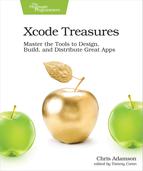About This Book
This is a book about the tool Xcode, not about the software development kits (SDKs) for the various Apple platforms. That means you should not make this your first book for learning iOS or macOS programming. This book is for developers who know the SDKs, at least a little, and want to get better at making apps.
Notice that the preceding paragraph said SDKs… plural. Xcode supports development for four platforms—iOS, macOS, tvOS, and watchOS—and this book embraces that diversity. You’ll find examples for all the Apple platforms, most obviously in Chapter 11, Platform Specifics, but also wherever it makes the most sense for the material. For example, in Chapter 2, Storyboards: Appearance, the examples use Mac storyboards to work with Auto Layout because it’s easier to see layout changes by resizing windows than by running on differently sized iPhone simulators. Don’t worry; Apple platforms share so much code in their SDKs, it’s not that hard for an iOS developer to get the hang of macOS, and vice versa.
Similarly, the book will use whatever Xcode-supported programming language best illustrates the material. While Swift is the default for most examples, some will use Objective-C or C, as is the case in Chapter 6, Debugging Code when inspecting memory buffers directly in the debugger, or catching errors that are only possible in those languages.
Each chapter takes on a more or less distinct topic, with little or no dependency on earlier material, so feel free to hop to whatever catches your interest from the table of contents. You don’t have to read the whole thing in order if you don’t want to.
